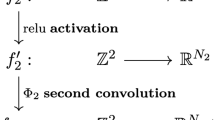Abstract
In this paper, we propose a new structure-preserving algorithm for computing the singular value decomposition of a quaternion matrix A. We first prove that the multiplication of two complex adjoint matrices will still be a complex adjoint matrix. Thus, utilizing this fact, we conduct a sequence of unitary complex adjoint matrices on a half of the elements of the complex adjoint matrix \(\chi _A\) of A instead of the whole \(\chi _A\). Then, we recover the resulting matrix with the help of the special structures. This method also reveals an efficient way to preserve some specific structures implicitly. Moreover, comparing with other algorithms, the numerical experiments show that our algorithm has higher accuracy when computing the QSVD of a large scale quaternion matrix.








Similar content being viewed by others
Data Availability
The data supporting the findings of this study are not publicly available due to privacy or ethical restrictions. However, interested researchers may request access to the data by contacting the corresponding author and completing any necessary data sharing agreements.
References
Bihan, N.L., Mars, J.: Singular value decomposition of quaternion matrices: a new tool for vector-sensor signal processing. Signal Process. 84(7), 1177–1199 (2004)
Bihan, N.L., Sangwine, S.J.: Jacobi method for quaternion matrix singular value decomposition. Appl. Math. Comput. 187(2), 1265–1271 (2007)
Datta, B.N.: Numerical Linear Algebra and Applications, 2nd edn. The SIAM, Philadelphia (2010)
Golub, G.H., Van Loan, C.F.: Matrix Computations, Johns Hopkins Studies in the Mathematical Sciences, vol 3 (2013)
He, Z.H., Ng, M.K., Zeng, C.: Generalized singular value decompositions for tensors and their applications. Numer. Math. Theory Methods Appl. 14(3), 692–713 (2021)
He, Z.H., Wang, X.X., Zhao, Y.F.: Eigenvalues of quaternion tensors with applications to color video processing. J. Sci. Comput. 94(1), 1 (2023)
Jacobson, N.: Basic Algebra I. Courier Corporation (2012)
Jia, Z.G., Ng, M.K., Song, G.J.: Lanczos method for large-scale quaternion singular value decomposition. Numer. Algorithms 82, 1–19 (2018)
Jia, Z.G., Wei, M.S., Ling, S.T.: A new structure-preserving method for quaternion Hermitian eigenvalue problems. J. Comput. Appl. Math. 239, 12–24 (2013)
Jia, Z.G. Ling, S.T., Zhao, M.X.: Color two-dimensional principal component analysis for face recognition based on quaternion model. In: LNCS 10361, ICIC (1), pp. 177–189 (2017)
Jia, Z.G., Liu, X., Zhu, J.F., Zhao, M.X.: Harmonic multi-symplectic Lanczos algorithm for quaternion singular triplets. Numer. Algorithms (2023). https://doi.org/10.1007/s11075-022-01469-7
Li, Y., Wei, M., Zhang, F., Zhao, J.: A fast structure-preserving method for computing the singular value decomposition of quaternion matrices. Appl. Math. Comput. 235, 157–167 (2014)
Li, Y., Wei, M., Zhang, F., Zhao, J.: Real structure-preserving algorithms of Householder based transformations for quaternion matrices. J. Comput. Appl. Math. 305, 82–91 (2016)
Ma, R.R., Bai, Z.J.: A structure-preserving one-sided Jacobi method for computing the SVD of a quaternion matrix. Appl. Numer. Math. 147, 101–117 (2020)
Pei, S.C., Chang, J.H., Ding, J.J.: Quaternion matrix singular value decomposition and its applications for color image processing. In: Image Processing, 2003. ICIP 2003. Proceedings. 2003 International Conference on IEEE Xplore (2003)
Rodman, L.: Topics in Quaternion Linear Algebra. Princeton Series in Applied Mathematics, Princeton University Press, Princeton (2014)
Sangwine, S.J., Bihan, N.L.: Quaternion toolbox for matlab. http://qtfm.sourceforge.net/
Sangwine, S.J., Bihan, N.L.: Quaternion singular value decomposition based on bidiagonalization to a real or complex matrix using quaternion householder transformations. Appl. Math. Comput. 182(1), 727–738 (2006)
Song, G.J., Wang, Q.W., Yu, S.W.: Cramer’s rule for a system of quaternion matrix equations with applications. Appl. Math. Comput. 336, 490–499 (2018)
Song, G.J., Ding, W.Y., Ng, M.K.: Low rank pure quaternion approximation for pure quaternion matrices. SIAM J. Matrix Anal. Appl. 42(1), 58–82 (2021)
The Georgia Tech face database. http://www.anefian.com/research/facereco.htm
Wang, Q.W., Wang, X., Zhang, Y.S.: A constraint system of coupled two-sided Sylvester-like quaternion tensor equations. Comput. Appl. Math. 39, 1–15 (2020)
Wang, Q.W., Wang, X.X.: Arnoldi method for large quaternion right eigenvalue problem. J. Sci. Comput. 82(3), 58 (2020)
Zhang, F.Z.: Quaternions and matrices of quaternions. Linear Algebra Appl. 251, 21–57 (1997)
Acknowledgements
The authors would like to thank Prof. Zhigang Jia’s help and the anonymous referees for their valuable comments and suggestions.
Funding
This research is supported by Macao Science and Technology Development Fund (No. 0013/2021/ITP), the grants from the National Natural Science Foundation of China (12371023, 12271338), and the Natural Sciences and Engineering Research Council of Canada (NSERC) (RGPIN 2020-06746), The Joint Research and Development Fund of Wuyi University, Hong Kong and Macao (2019WGALH20), Macau University of Science and Technology Faculty Research Grants (FRG-22-073-FIE).
Author information
Authors and Affiliations
Corresponding author
Ethics declarations
Conflict of interest
The authors have not disclosed any conflict of interest.
Additional information
Publisher's Note
Springer Nature remains neutral with regard to jurisdictional claims in published maps and institutional affiliations.
Rights and permissions
Springer Nature or its licensor (e.g. a society or other partner) holds exclusive rights to this article under a publishing agreement with the author(s) or other rightsholder(s); author self-archiving of the accepted manuscript version of this article is solely governed by the terms of such publishing agreement and applicable law.
About this article
Cite this article
Yu, CE., Liu, X. & Zhang, Y. A New Complex Structure-Preserving Method for QSVD. J Sci Comput 99, 37 (2024). https://doi.org/10.1007/s10915-024-02496-3
Received:
Revised:
Accepted:
Published:
DOI: https://doi.org/10.1007/s10915-024-02496-3



